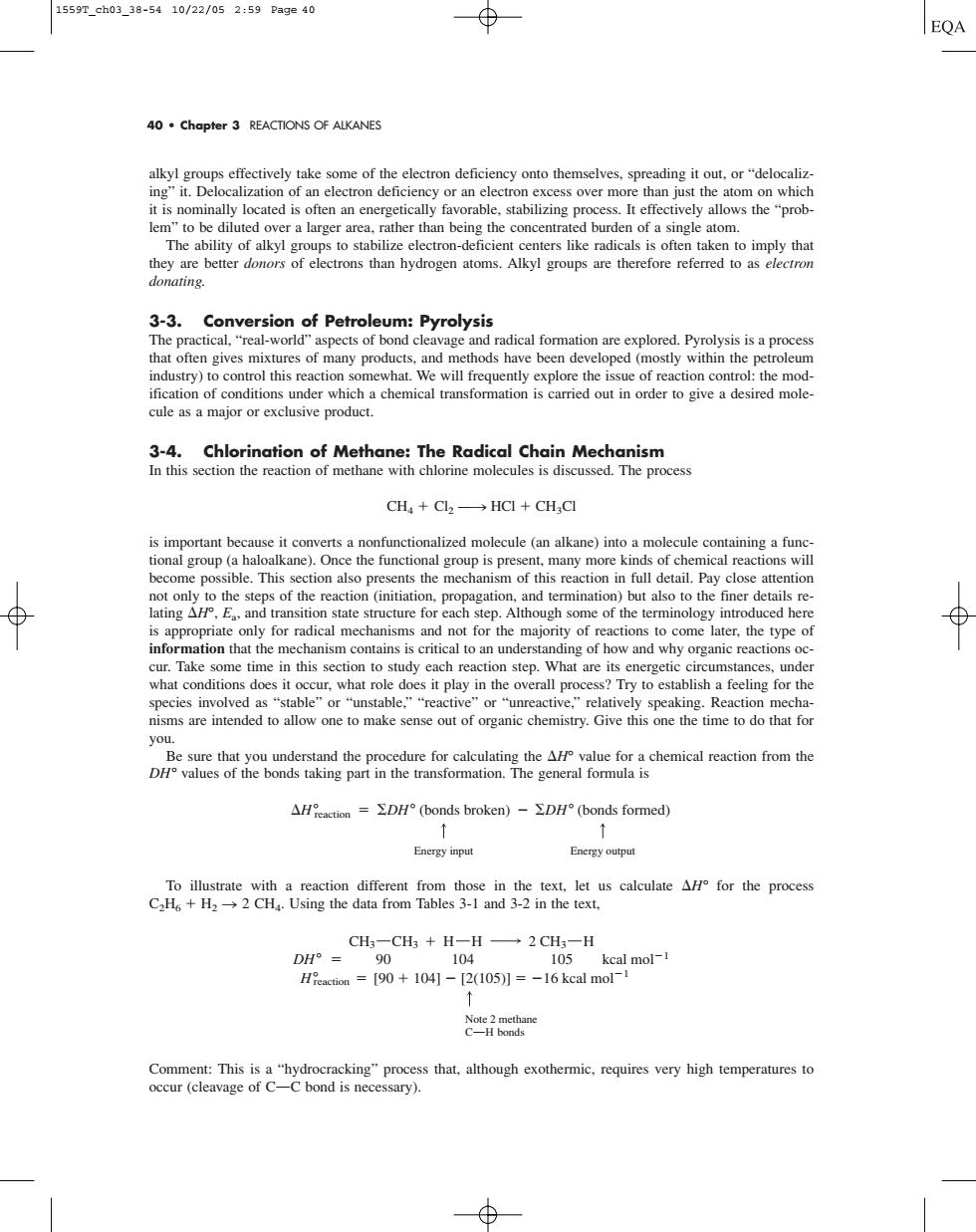正在加载图片...

1559rch0338-5410/22/052:59Page40 EQA 40.Chapter 3 REACTIONS OF ALKANES lem"to be diluted over a larger area.rather than being the concentrated burden of a single atom. lty of alky 3-3.Conversion of Petroleum:Pyrolysis aspects of bond cle hat.issue of eaction the mod ch a chemical transformation is carried out in order to give a desired mole Itscto the choine olcueTe pre Chloringtion of Methane:The radical chain mechanism CH,+C2→HCI+CH,C kane )On ce the functic I group is pre many more k agation,and termination)but also to the finer details re state structure for Although some o t the terminology intro ced he information that the mechanism contains is critical to an understanding of how and why reactions oc Take some time in this section to study each reaction stp. What are its energetic ve"r nismsr intended toallowon to makesesou of oranic chemisry.Give thison the time to do that for you dakins th somtoochemical reaction from the △ection=DH°(bonds broken)-DH°(bonds formed Energy inpu nergy CH,-CH+H-H一2CH-H DH°= 90 104 10 kcal mol- =[0+104]-[2(105)]=-16 kcal mol c1 cess that,although exothermic.requires very high temperatures to40 • Chapter 3 REACTIONS OF ALKANES alkyl groups effectively take some of the electron deficiency onto themselves, spreading it out, or “delocalizing” it. Delocalization of an electron deficiency or an electron excess over more than just the atom on which it is nominally located is often an energetically favorable, stabilizing process. It effectively allows the “problem” to be diluted over a larger area, rather than being the concentrated burden of a single atom. The ability of alkyl groups to stabilize electron-deficient centers like radicals is often taken to imply that they are better donors of electrons than hydrogen atoms. Alkyl groups are therefore referred to as electron donating. 3-3. Conversion of Petroleum: Pyrolysis The practical, “real-world” aspects of bond cleavage and radical formation are explored. Pyrolysis is a process that often gives mixtures of many products, and methods have been developed (mostly within the petroleum industry) to control this reaction somewhat. We will frequently explore the issue of reaction control: the modification of conditions under which a chemical transformation is carried out in order to give a desired molecule as a major or exclusive product. 3-4. Chlorination of Methane: The Radical Chain Mechanism In this section the reaction of methane with chlorine molecules is discussed. The process CH4 Cl2 On HCl CH3Cl is important because it converts a nonfunctionalized molecule (an alkane) into a molecule containing a functional group (a haloalkane). Once the functional group is present, many more kinds of chemical reactions will become possible. This section also presents the mechanism of this reaction in full detail. Pay close attention not only to the steps of the reaction (initiation, propagation, and termination) but also to the finer details relating H°, Ea, and transition state structure for each step. Although some of the terminology introduced here is appropriate only for radical mechanisms and not for the majority of reactions to come later, the type of information that the mechanism contains is critical to an understanding of how and why organic reactions occur. Take some time in this section to study each reaction step. What are its energetic circumstances, under what conditions does it occur, what role does it play in the overall process? Try to establish a feeling for the species involved as “stable” or “unstable,” “reactive” or “unreactive,” relatively speaking. Reaction mechanisms are intended to allow one to make sense out of organic chemistry. Give this one the time to do that for you. Be sure that you understand the procedure for calculating the H° value for a chemical reaction from the DH° values of the bonds taking part in the transformation. The general formula is To illustrate with a reaction different from those in the text, let us calculate H° for the process C2H6 H2 n 2 CH4. Using the data from Tables 3-1 and 3-2 in the text, Comment: This is a “hydrocracking” process that, although exothermic, requires very high temperatures to occur (cleavage of COC bond is necessary). reaction [90 104] [2(105)] 16 kcal mol1 kcal mol1 DH 90 104 105 Note 2 methane C—H bonds CH3 CH3 H H 2 CH3 H H reaction DH (bonds broken) Energy input DH (bonds formed) Energy output H 1559T_ch03_38-54 10/22/05 2:59 Page 40��������